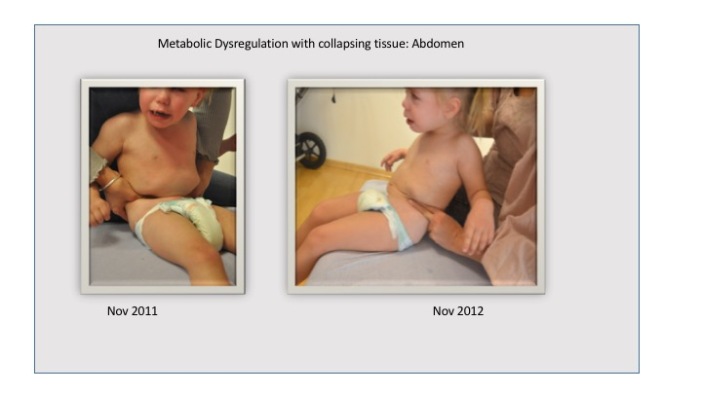Two weeks after making contact with the ABR team, I found myself in the car driving the five hours to Vienna for our first assessment. Emma was now almost two years old. We had made no progress despite intensive neurorehabiltative work. We were doing physiotherapy about twice a week, and on the other three days we spent afternoons working with conductive education. Emma had made cognitive gains, but motor function was an issue. She could not sit, hold her head or eat properly.
The first session was unlike any I had ever experienced in clinical care. There were a team of people in the room. There was video and photography equipment. Emma needed to be undressed and was examined thoroughly. It was a physical exam I had never seen before. Instead of eliciting reflexes and testing for other neurological deficits, Emma’s structure was examined. I was shown where her weakened tissue was collapsing. Places where there had been a stagnation of development were pointed out – like the unbendable spine that was still in a foetal curve. In addition they showed me her paradoxical breathing (this is where the chest collapses when she inhales). I have added in a photo of how she looked in a sitting position in the first ABR assessment. The other photo was taken a year later.
They said we needed to find her neutral position. This is the position in which she can come to complete relaxation. In Emma’s case this was lying down and not moving. Any movement induced would be like an earthquake for her. She would go into a pronounced startle response with her arms extended and her back arched. After this examination (it took a full hour) they talked to me about my goals. I told them I am prepared to do whatever it takes. That I would love to see her use her hands, sit and crawl.
They gently explained that if Emma cannot even “be” relaxed and neutral, if she cannot even breathe properly, that if she cannot even hold her head up properly, then setting; goals like sitting and crawling makes no sense. They promised me that eventually we would get there, but her first progress must be in the sub-surface biochemistry and structure before anything more would be possible. They explained how we would bring relaxation to the spasticity over the next few months, how we would stimulate metabolism and work on the chest strength and shape in order to bring better breathing.
They explained that in order to sit, one needs a movable spine and that the trunk structures should “hold up” and not collapse in like they were during Emma’s exam.

They helped me understand that Emma needed relaxation and not hours of training since her structure was too weak to handle it and that it would take so much energy from her system that there would be none left for metabolic processes, like muscle development and gut function.
This was all new to me. But it made sense! I truly had nothing left to lose. We committed for one year and said we would give this experiment a try. Within weeks she was more relaxed and her constipation improved. For other functions, we had to work patiently over more months.
Of all the therapies I tried, this one made all the difference.
I also like the ABR Americas website.
Post script: October 2016: Another connective tissue targeting therapy called BDA, is now active in Slovenia, Kazakstan, South Africa and Russia with excellent results.